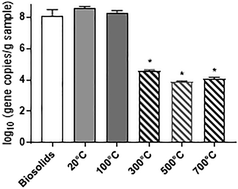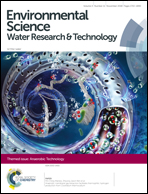Effect of pyrolysis on the removal of antibiotic resistance genes and class I integrons from municipal wastewater biosolids
Abstract
Wastewater biosolids represent a significant reservoir of antibiotic resistance genes (ARGs). While current biosolids treatment technologies can reduce ARG levels in residual wastewater biosolids, observed removal rates vary substantially. Pyrolysis is an anoxic thermal degradation process that can be used to convert biosolids into energy rich products including py-gas and py-oil, and a beneficial soil amendment, biochar. Batch pyrolysis experiments conducted on municipal biosolids revealed that the 16S rRNA gene, the ARGs erm(B), sul1, tet(L), tet(O), and the integrase gene of class 1 integrons (intI1) were significantly reduced at pyrolysis temperatures ranging from 300–700 °C, as determined by quantitative polymerase chain reaction (qPCR). Pyrolysis of biosolids at 500 °C and higher resulted in approximately 6-log removal of the bacterial 16S rRNA gene. ARGs with the highest observed removals were sul1 and tet(O), which had observed reductions of 4.62 and 4.04-log, respectively. Pyrolysis reaction time had a significant impact on 16S rRNA, ARG and intI1 levels. A pyrolysis residence time of 5 minutes at 500 °C reduced all genes to below detection limits. These results demonstrate that pyrolysis could be implemented as a biosolids polishing treatment technology to substantially decrease the abundance of total bacteria (i.e., 16S rRNA), ARGs and intI1 prior to land application of municipal biosolids.

- This article is part of the themed collections: Best Papers 2018 – Environmental Science: Water Research & Technology and Anaerobic Technology


 Please wait while we load your content...
Please wait while we load your content...